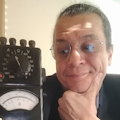The International Microwave Symposium Goes Virtual (Part 3)
This article appeared in Evaluation Engineering and has been published here with permission.
Don’t forget to check out:
The International Microwave Symposium Goes Virtual (Part 1)
The International Microwave Symposium Goes Virtual (Part 2)
5G Beamforming
Radio performance has become a critical device enabler today. The ability for an IoT product to be able to seamlessly travel through the Cloud and use all of the available RF infrastructures will be a powerful force multiplier. Advanced antennas, ICs, topologies, and protocols are needed to create the optimum solution.
At the Anokiwave booth, the company was touting its portfolio of silicon ICs for millimeter-wave (mmWave) 5G, SATCOM, and radar applications. The company pointed out how its specialty and advanced design capabilities create some of the industry’s highest-performing 3GPP-compliant 5G radios, for applications from 5G infrastructure to consumer premise equipment (CPE). And now with their second-generation SATCOM ICs, Anokiwave is enabling the market for LEO/MEO/GEO satellite ground and aero equipment.
Here’s a clip explaining mmWave 5G beamforming using technology developed by Anokiwave:
In the area of space development, Anokiwave and hiSky recently announced a collaboration to enable the next generation of low-cost voice, data, and IoT SATCOM terminals. As part of this collaboration, Anokiwave will provide its ICs in Ku and K/Ka band, and hiSky will provide small form-factor terminal-based phased-array antennas, for commercial and industrial applications.
Advanced Embedded Systems
No matter how sophisticated the software, it still needs high-performance hardware embedded systems to run on. Pentek designs embedded computer boards and recording systems for DSP, software radio, and data acquisition, with high-speed digital and analog interfaces and FPGAs in AMC, XMC, FMC, PMC, cPCI, PCIe, and VPX.
In Pentek's virtual booth, the company presented a webinar providing a look at how RFSoC compares to the current trends in analog-to-digital and digital-to-analog converters (ADCs and DACs). Presented by Rodger H. Hosking, vice-president and co-founder of Pentek, the video covers on-chip resources in detail and board and system design considerations are discussed, including power, IP optimization, and standard and custom module sizes. The video also covered the support circuitry needed for optical interfaces and connections, memory, clocking, and high-signal integrity for RF inputs and outputs.
The company also recently introduced an addition to its Model 7050 RFSoC Architecture family, an eight-channel analog-to-digital and digital-to-analog converter, PCIe double-wide board based on the Xilinx Zynq UltraScale+ RFSoC. The Model 7050 brings RFSoC performance to PC platforms with a complete system on a board. The solution targets 5G and LTE wireless, SIGINT and COMINT, EW countermeasures, radar on a chip, test and measurement, satellite communications, and LiDAR applications.
RF Test
Of course, test, measurement, and evaluation is becoming more and more important to address the crowded spectrum, and optimizing the devices within it. thinkRF provides compact, networkable RF spectrum analyzers and downconverter/tuners that are deployable without a PC. The company’s virtual booth was promoting its solutions for applications such as spectrum monitoring, signal analysis and demodulation, TSCM, SIGINT/ELINT, telecom deployment and optimization, and others.
Among the systems promoted at the virtual booth built on the company’s innovative software-defined radio (SDR) technologies, the thinkRF R5550 Real-Time Spectrum Analyzer has the performance of traditional lab-grade spectrum analyzers at a fraction of the cost, size, weight and power consumption. Designed for distributed deployment in the lab, in the field, or in a vehicle, the portable, fanless thinkRF R5550 provides the benefits of a high-performance software-defined RF receiver, digitizer, and analyzer.
The lightweight R5550 analyzer offers improved spectral performance in a rugged form factor. Based on an optimized SDR receiver architecture, coupled with real-time digitization and digital signal processing, the device enables wide bandwidth, deep dynamic range, and 27-GHz frequency range in a small, stylish one-box platform.
The company also recently launched the D4000 RF Downconverter/Tuner, presented as the industry’s first 40-GHz downconverter/tuner with a frequency range from 24 to 40 GHz with up to 500 MHz of real-time bandwidth (RTBW) to capture mmWave 5G signals. To leverage the performance, latency, and capacity that 5G promises, you need equipment which can properly analyze the higher frequencies and wider bandwidths of these new signals. This compact, plug-and-play thinkRF downconverter/tuner can upgrade existing field, lab, and manufacturing test equipment, significantly reducing time to market and cost.
Dedication to Simulation
It’s a common demand from the engineering community to have the best in test, simulation, evaluation, and troubleshooting capability. The difference in being able to optimize a system by simulating its performance in various iterations is a critical design advantage in product development.
Visitors to the MathWorks virtual booth at the conference can see a range of tools built on the company’s platform products, MATLAB and Simulink. Used to model, simulate, and deploy communications, radar, and EW systems, their tools span the RF, antenna, phased array, signal processing, and data processing disciplines. Some highlights include its Wireless Waveform Generator App, Antenna Array Designer App, as well as improved antenna optimization workflows and installed antenna analysis for large structures.
The company points out how you can perform coverage analysis using ray-tracing propagation models in complex urban environments, connect MATLAB to RF network analyzers to characterize designs, and use MATLAB and Simulink to develop systems on the RFSoC platform for communications and radar applications. You can apply deep-learning techniques such as modulation identification, RF fingerprinting, spectrum management, channel estimation, and target classification, in addition to validating your results with off-the-shelf radios and radars
A Manufacturing Partner
MACOM designs and manufactures semiconductor products for data-center, telecommunication, industrial, and defense applications. At its virtual booth, the Massachusetts-based company emphasized its design centers and sales offices throughout North America, Europe, and Asia, where you can have their professionals help you create your design. MACOM is certified to the ISO9001 international quality standard, and ISO14001 environmental management standard.
At the show, among other product releases, the company introduced its latest GaN-on-SiC “Pure Carbide” power amplifier product line, with the MAPC-A1000 and the MAPCA1100 first released. “This new product line significantly enhances the capability of our existing RF Power product portfolio," said Stephen G. Daly, President and Chief Executive Officer of MACOM. “GaN on silicon carbide is a compelling technology, and we are excited to begin offering our customers both standard and custom MACOM Pure Carbide power amplifier solutions.”
The MAPC-A1000 is a high-power GaN-on-SiC amplifier designed to operate between 30 MHz and 2.7 GHz, integrating an input match that simplifies the design-in effort. The amplifier can deliver more than 25 W (44 dBm) at greater than 50% efficiency from 500 MHz to 2.7 GHz when tested in a circuit designed for operation over 2.2-GHz simultaneous bandwidth.
The MAPC-A1100 is a high-power GaN-on-SiC amplifier designed to operate up to 3.5 GHz, capable of supporting both CW and pulsed operations, with output power levels of at least 65 W (48.1 dBm) in an air cavity ceramic package. The two new general-purpose amplifier products target avionics, high-power mobile radios, wireless systems, and test instrumentation.
About the Author
Alix Paultre
Editor-at-Large, Microwaves & RF
Alix is Editor-at-Large for Microwaves & RF.
An Army veteran, Alix Paultre was a signals intelligence soldier on the East/West German border in the early ‘80s, and eventually wound up helping launch and run a publication on consumer electronics for the U.S. military stationed in Europe. Alix first began in this industry in 1998 at Electronic Products magazine, and since then has worked for a variety of publications, most recently as Editor-in-Chief of Power Systems Design.
Alix currently lives in Wiesbaden, Germany.


